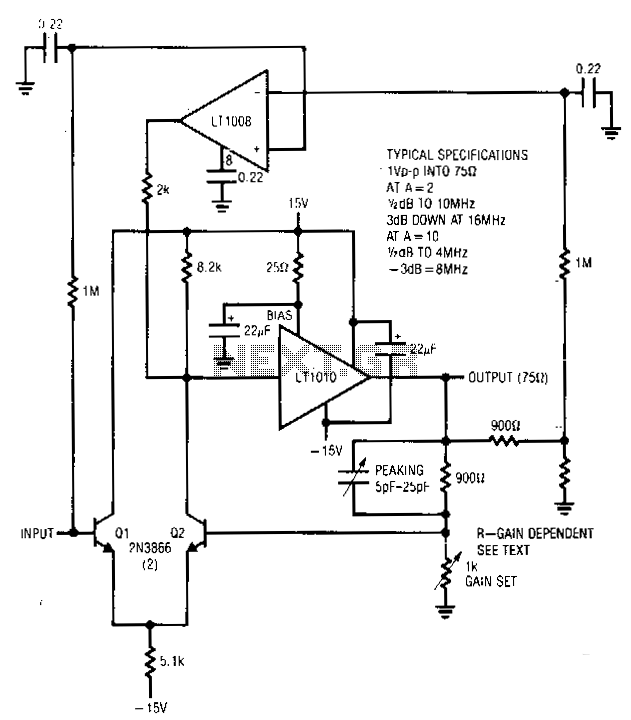
Stabilized-amplifier

This amplifier operates across a broad range of gains, typically from 1 to 10. It integrates the LT1010 with a fast discrete stage and an LT1008-based destabilizing loop. Transistors Q1 and Q2 create a differential stage that converts to a single-ended output into the LT1010. The circuit provides a 1 V peak-to-peak output into a standard 75-ohm video load. At a gain of 2, the gain remains stable within 0.5 dB up to 10 MHz, with the -3 dB point at 16 MHz. At a gain of 10, the gain is flat within ±0.5 dB up to 4 MHz, with a -3 dB point at 8 MHz. The peaking adjustment should be optimized under loaded output conditions. This amplifier stage is designed for fast applications requiring a relatively low output swing. Its 1 V peak-to-peak output is suitable for video circuits. A potential issue is the relatively high bias current, typically 10 µA. Additional output swing is achievable, but it necessitates more circuitry.
This amplifier is designed to provide versatility in gain settings, making it suitable for various applications, particularly in video signal processing. The integration of the LT1010 with a fast discrete stage allows for rapid response times, essential for high-frequency applications. The LT1008 serves as a stabilizing loop, ensuring the amplifier maintains performance across its specified gain range.
The differential stage formed by transistors Q1 and Q2 is critical for achieving the desired single-ended output. This configuration enhances linearity and reduces distortion, which is vital in maintaining signal integrity, especially in video applications where fidelity is paramount.
The output specifications indicate that the amplifier can drive a 75-ohm load effectively, making it ideal for standard video equipment. The performance metrics at different gain settings highlight the amplifier's capability to maintain a flat gain response over specified frequency ranges, which is crucial for applications requiring consistent signal amplification without unwanted frequency-dependent variations.
The peaking adjustment feature is particularly important, as it allows for fine-tuning the amplifier's response under actual load conditions, ensuring optimal performance in practical scenarios. While the bias current of 10 µA may be considered high for some low-power applications, it is a trade-off for achieving the desired speed and output characteristics.
For applications requiring higher output swings, additional circuitry can be implemented. This may involve incorporating additional stages or using complementary components to manage the increased current demands and maintain linearity. Overall, this amplifier design is well-suited for fast, low-output swing applications, particularly in video signal processing where performance and reliability are critical.This amplifier functions over a wide range of gains, typically 1-10. It combines the LT1010 and a fast discrete stage with an LT1008 based de stabilizing loop. Q1 and Q2 form a differential stage which single-ends into the LT1010. The circuit delivers 1 V pk-pk into a typical 75-0 video load. At A = 2, the gain js within 0.5 dB to 10 MHz with the - 3-dB point occurring at 16 MHz. At A = 10, the gain is flat (±0.5 dB to 4 MHz) with a -3-dB poinLat 8 MHz. The pealring adjustment should be optimized under loaded output conditions. This is a simple stage for fast applications where relatively low output swing is required. Its 1 V pk-pk output works nicely for video circuits. A possible problem is the relatively high bias current, typically 10uA. Additional swing is possible, but more circuitry is needed.
This amplifier is designed to provide versatility in gain settings, making it suitable for various applications, particularly in video signal processing. The integration of the LT1010 with a fast discrete stage allows for rapid response times, essential for high-frequency applications. The LT1008 serves as a stabilizing loop, ensuring the amplifier maintains performance across its specified gain range.
The differential stage formed by transistors Q1 and Q2 is critical for achieving the desired single-ended output. This configuration enhances linearity and reduces distortion, which is vital in maintaining signal integrity, especially in video applications where fidelity is paramount.
The output specifications indicate that the amplifier can drive a 75-ohm load effectively, making it ideal for standard video equipment. The performance metrics at different gain settings highlight the amplifier's capability to maintain a flat gain response over specified frequency ranges, which is crucial for applications requiring consistent signal amplification without unwanted frequency-dependent variations.
The peaking adjustment feature is particularly important, as it allows for fine-tuning the amplifier's response under actual load conditions, ensuring optimal performance in practical scenarios. While the bias current of 10 µA may be considered high for some low-power applications, it is a trade-off for achieving the desired speed and output characteristics.
For applications requiring higher output swings, additional circuitry can be implemented. This may involve incorporating additional stages or using complementary components to manage the increased current demands and maintain linearity. Overall, this amplifier design is well-suited for fast, low-output swing applications, particularly in video signal processing where performance and reliability are critical.This amplifier functions over a wide range of gains, typically 1-10. It combines the LT1010 and a fast discrete stage with an LT1008 based de stabilizing loop. Q1 and Q2 form a differential stage which single-ends into the LT1010. The circuit delivers 1 V pk-pk into a typical 75-0 video load. At A = 2, the gain js within 0.5 dB to 10 MHz with the - 3-dB point occurring at 16 MHz. At A = 10, the gain is flat (±0.5 dB to 4 MHz) with a -3-dB poinLat 8 MHz. The pealring adjustment should be optimized under loaded output conditions. This is a simple stage for fast applications where relatively low output swing is required. Its 1 V pk-pk output works nicely for video circuits. A possible problem is the relatively high bias current, typically 10uA. Additional swing is possible, but more circuitry is needed.